

Jrc98209 r digcomporg final. 20 Things Educators Need To Know About Digital Literacy Skills. Tracing the Roots of Media Literacy: Raymond Williams and John Fiske. A while back, media literacy educator and advocate Renee Hobbs approached me about contributing an essay to a new anthology she was editing: Hobbs asked some leading scholars to share personal essays about the people who have influenced their own thinking about media, popular culture, and learning.

I was asked to contribute something about the role Birmingham cultural studies had played in the development of media literacy, and I was happy to agree. We were supposed to describe our intellectual “grandparents”, and I ended up writing a deeply personal essay that discussed the relationship between my work on participatory culture and that of Raymond Williams and John Fiske. Along the way, I also shared something of my biological grandparents — on my father’s side — and the ways I saw myself in some of William’s more autobiographical writings. What follows is an excerpt from my contribution. There’s more where this comes from: Along with the historian E. Education Update:Reading the Blueprint:Dawn of the New Literacies.
Digital literacies in the age of remix. This site uses cookies from Google to deliver its services, to personalise ads and to analyse traffic.

Information about your use of this site is shared with Google. By using this site, you agree to its use of cookies.Learn moreGot it About Me Steve Wheeler I'm Associate Professor of learning technology in the Plymouth Institute of Education at Plymouth University. Picture Loading. EJNoLongerALuxury. Navigating the Digital Transformation Journey – Digital Promise.
| by Digital Promise You lower your hands to the ground and feel the texture of the rubber track against your fingertips.
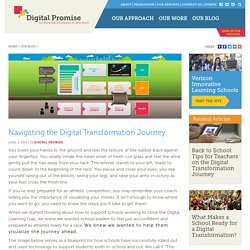
You slowly inhale the clean smell of fresh-cut grass and feel the wind gently pull the hair away from your face. The referee stands to your left, ready to count down to the beginning of the race. You pause and close your eyes; you see yourself spring out of the blocks, swing your legs, and raise your arms in victory as your feet cross the finish line. If you’ve ever prepared for an athletic competition, you may remember your coach telling you the importance of visualizing your moves. When we started thinking about how to support schools working to close the Digital Learning Gap, we knew we wanted school leaders to feel just as confident and prepared as athletes ready for a race. The image below serves as a blueprint for how schools have successfully rolled out and used technology to support students, both in-school and out.
Ready to Commit. 20 Things Educators Need To Know About Digital Literacy Skills - InformED. Navigating the Digital Transformation Journey – Digital Promise. Digital Skills Is Not The Same As Digital Literacy – FINDING HEROES. Digital skills is following a step by step process of creating an email account.
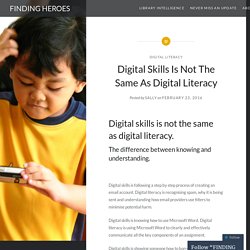
The death of the digital native: four provocations from Digifest speaker, Donna Lanclos. In these four provocations, anthropologist Donna Lanclos argues that the notion of the "digital native" is bogus and disempowering, that pandering to student expectations can backfire, universities should be open by default, and our attitude to educational technology needs a rethink.
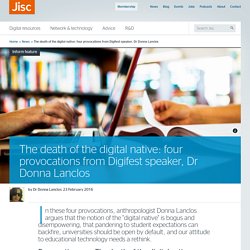
Provocation one: The death of the digital native The 'digital native' is a generational metaphor. It's a linguistic metaphor. It's a ridiculous metaphor. What is digital fluency? Image by George Couros under CC A recent announcement from Hon. Hekia Parata signalled that digital fluency will be a key focus for Ministry centrally-funded professional learning support in 2016 (PLD Changes will lift student achievement, 23 Sept. 2015). The value of growing digitally fluent learners was signalled in the Ministry report, Future Focused Learning in Connected Communities (2014) which asked that “digital competencies be recognised as “essential foundation skills for success in 21st century society” and that they be supported by “cross-curriculum resources, a responsive assessment framework, professional development and a programme of evaluation.”
‘Digital fluency’, as a phrase, does not occur specifically in the our various curricula (NZC, Te Marautanga, Te Whāriki) or in other oft-used touchstones for learning with digital technologies. Taking Control of Your Digital Identity. A friend told me I was “going rogue” when I leased a slice of off-campus server to host The Social Media Classroom for my UC Berkeley and Stanford courses.
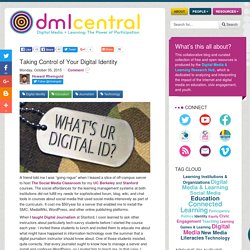
The social affordances for the learning management systems at both institutions did not fulfill my needs for sophisticated forum, blog, wiki, and chat tools in courses about social media that used social media intensively as part of the curriculum. It cost me $50/year for a server that enabled me to install the SMC, MediaWiki, WordPress, and other online publishing platforms. When I taught Digital Journalism at Stanford, I soon learned to ask other instructors about particularly tech-savvy students before I started the course each year. I invited these students to lunch and invited them to educate me about what might have happened in information technology over the summer that a digital journalism instructor should know about.
Banner image: Gideon Burton 572 total views, 2 views today. Digital Compass....A Brand New Way To Teach Digital Literacy and Citizenship To Our Kids! Our friends at Common Sense Media have done it again!

They have brought us something wonderful to use with our young people in grades 6th through 9th. Making Digital Artifacts Work: Part 1. This is the first post in a series about making digital artifacts of student learning work for you as a teacher.
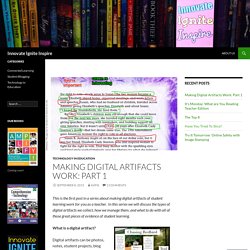
In this series we will discuss the types of digital artifacts we collect, how we manage them, and what to do with all of those great pieces of evidence of student learning. What is a digital artifact? Digital artifacts can be photos, notes, student projects, blog posts, Tweets and just about anything that students create using digital tools. They comprise a mixture of student created and teacher documented artifacts of learning over the course of the year. Digital artifacts are great supplements, in some cases replacements, to traditional artifacts that we collect in the classroom because they add elements that we wouldn’t have otherwise been able to capture. The Ultimate list of Free Stock Photos Sites for eLearning. Are you looking for free e-learning images, photos, cliparts or illustrations?

In this post I will present you The Ultimate list of Free Stock Photos Sites for eLearning. If anyone of you have used one or more of the above Free Stock Photos Sites I will very much appreciate if he/she share with us his experience! If you know another Free Stock Photos Sites that is not included in the list I will highly appreciate if you leave a comment with a link! PublicDomainPictures.net is a repository for free public domain photos. You can download high quality photos, upload your own pictures, earn money to charity, get exposure and gain popularity and improve your photographic and graphic skills.FreeImages is not just another clipart graphic site!.... Get 2 Free eBooks. Teacher Tap: Public Domain, Copyright Free, Open Source, and Student Use Images and Media. This page provides links to some of the better copyright-free and public domain resources.
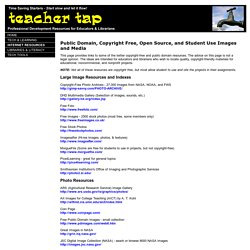
The advice on this page is not a legal opinion. The ideas are intended for educators and librarians who wish to locate quality, copyright-friendly materials for educational, noncommercial, and nonprofit projects. NOTE: Not all of these resources are copyright free, but most allow student to use and cite the projects in their assignments. Copryight-Free Photo Archives - 27,000 images from NASA, NOAA, and FWS DHD Multimedia Gallery (Selection of images, sounds, etc.) Free photos for education. Digital skills should be core subjects, says report. Children should be taught "digital literacy" as a core skill alongside maths and English, a report by a House of Lords committee says.
Computer technology brings "huge opportunities for the UK, but also significant risks", the Lords Digital Skills Committee warns. The internet should be viewed as a utility service, alongside water and electricity, it says. But without action, the UK may fall behind in the new digital era. 'Ambitious approach' The reports says: Digital Literacy is Crucial for Reading and Writing Instruction.
Literacy is known as the ability to read for knowledge, write coherently, and think critically about a language. The 8 Steps of A Great Digital Storytelling Process. March , 2014 Integrating digital storytelling requires more than just knowledge of the web tools to use for creating and sharing digital stories, the process if much more important. Helping kids and students learn through the use of digital storytelling entails the implementation of a well-paced plan that clearly outlines both the objectives and expectations behind this integration.
Samantha Morra (Google certified teacher) has this wonderful visual on the process of digital storytelling. This process comprises 8 steps : Come with an ideaResearch/explore and learnWrite/ScriptStoryboard/PlanGather/create images, gather/create audio, gather create video.Put it all togetherShareFeedback and reflect. Digital Literacy: Unlocking Technology's Potential. With 1:1 technology initiatives and BYOD (Bring Your Own Device) programs increasingly being implemented in schools across the globe, the need for digital literacy education has become more important than ever. Although technology enables students to access more information in much less time, it does not always foster learning.
Teaching digital literacy helps to manage all of the benefits of technology while helping students understand how to safely weed through the vast amounts of information online. Technology in the classroom has the following advantages: Digital Literacy & Citizenship Classroom Curriculum. NEW! A Universal Framework For Modern Literacy Pedagogy. A Universal Framework For Modern Literacy Pedagogy by Terry Heick. Social Media in Education: Resource Toolkit. Creating Social Media Guidelines A Guidebook for Social Media in the Classroom, by Vicki Davis (2014) Davis, in the first half of a pro-and-con discussion about social media in the classroom, positions it as a vital life skill and provides 12 positive examples of classroom use.
Digital Literacy. MediaSmarts. The Definition Of Digital Literacy. What is Digital Literacy? TEDxWarwick - Doug Belshaw - The Essential Elements of Digital Literacies. Definition: Digital Literacy. Digital Literacy Resource - Introduction. Digital literacy is the ability to find, evaluate, utilize, share, and create content using information technologies and the Internet.
Doug-belshaw-edd-thesis-final.pdf. What is Digital Literacy? Colleagues, Digital Literacy Home. Cornell University - Digital Literacy Resource. What is Digital Literacy? - Purposeful Technology-Constructing Meaning in 21st Century Schools. Communication Learning. What is digital literacy? Digital literacy is the topic that made the ETMOOC learning space so irresistible to me… I think as educators we spout off about wanting our students to be digitally literate, but not many of us (myself included) have a firm grasp about what that actually means, and quite a number of us are still attempting to become digitally literate ourselves. Whatever that means. Online Safety: A Teacher’s Guide to Dealing with Cyberbullying, Sexting, and Student Privacy. Teaching The Concept Of Digital Footprint To Middle School Students. The Urgency of Digital and Media-Literacy Skills. Awesome Visual Featuring 13 Important Google Search Tips for Students. The 8 Digital Literacy Practices Required for 21st Century Learners.
4 Education Technology Myths to Leave Behind in 2015 - Top Hat Blog. Is the Cell Phone the New Pencil? The 6 Major Skills for 21st Century Students. January 2015: Literacies for the digtal age: Numeracy.